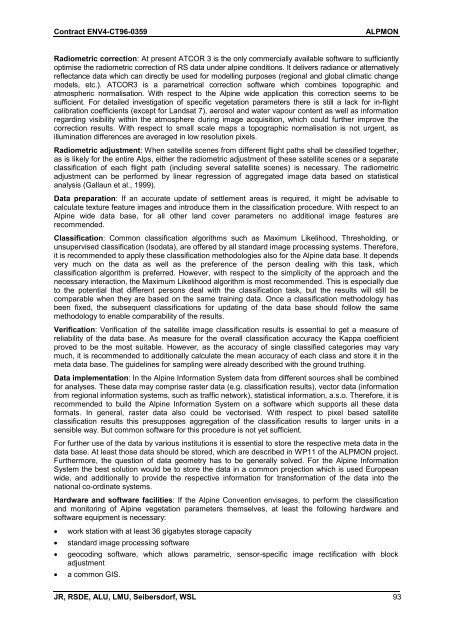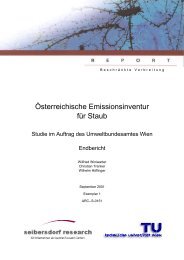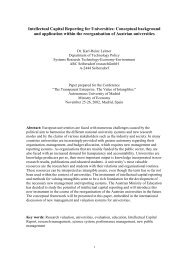ALPMON FINAL REPORT - ARC systems research
ALPMON FINAL REPORT - ARC systems research
ALPMON FINAL REPORT - ARC systems research
Create successful ePaper yourself
Turn your PDF publications into a flip-book with our unique Google optimized e-Paper software.
Contract ENV4-CT96-0359 <strong>ALPMON</strong><br />
Radiometric correction: At present ATCOR 3 is the only commercially available software to sufficiently<br />
optimise the radiometric correction of RS data under alpine conditions. It delivers radiance or alternatively<br />
reflectance data which can directly be used for modelling purposes (regional and global climatic change<br />
models, etc.). ATCOR3 is a parametrical correction software which combines topographic and<br />
atmospheric normalisation. With respect to the Alpine wide application this correction seems to be<br />
sufficient. For detailed investigation of specific vegetation parameters there is still a lack for in-flight<br />
calibration coefficients (except for Landsat 7), aerosol and water vapour content as well as information<br />
regarding visibility within the atmosphere during image acquisition, which could further improve the<br />
correction results. With respect to small scale maps a topographic normalisation is not urgent, as<br />
illumination differences are averaged in low resolution pixels.<br />
Radiometric adjustment: When satellite scenes from different flight paths shall be classified together,<br />
as is likely for the entire Alps, either the radiometric adjustment of these satellite scenes or a separate<br />
classification of each flight path (including several satellite scenes) is necessary. The radiometric<br />
adjustment can be performed by linear regression of aggregated image data based on statistical<br />
analysis (Gallaun et al., 1999).<br />
Data preparation: If an accurate update of settlement areas is required, it might be advisable to<br />
calculate texture feature images and introduce them in the classification procedure. With respect to an<br />
Alpine wide data base, for all other land cover parameters no additional image features are<br />
recommended.<br />
Classification: Common classification algorithms such as Maximum Likelihood, Thresholding, or<br />
unsupervised classification (Isodata), are offered by all standard image processing <strong>systems</strong>. Therefore,<br />
it is recommended to apply these classification methodologies also for the Alpine data base. It depends<br />
very much on the data as well as the preference of the person dealing with this task, which<br />
classification algorithm is preferred. However, with respect to the simplicity of the approach and the<br />
necessary interaction, the Maximum Likelihood algorithm is most recommended. This is especially due<br />
to the potential that different persons deal with the classification task, but the results will still be<br />
comparable when they are based on the same training data. Once a classification methodology has<br />
been fixed, the subsequent classifications for updating of the data base should follow the same<br />
methodology to enable comparability of the results.<br />
Verification: Verification of the satellite image classification results is essential to get a measure of<br />
reliability of the data base. As measure for the overall classification accuracy the Kappa coefficient<br />
proved to be the most suitable. However, as the accuracy of single classified categories may vary<br />
much, it is recommended to additionally calculate the mean accuracy of each class and store it in the<br />
meta data base. The guidelines for sampling were already described with the ground truthing.<br />
Data implementation: In the Alpine Information System data from different sources shall be combined<br />
for analyses. These data may comprise raster data (e.g. classification results), vector data (information<br />
from regional information <strong>systems</strong>, such as traffic network), statistical information, a.s.o. Therefore, it is<br />
recommended to build the Alpine Information System on a software which supports all these data<br />
formats. In general, raster data also could be vectorised. With respect to pixel based satellite<br />
classification results this presupposes aggregation of the classification results to larger units in a<br />
sensible way. But common software for this procedure is not yet sufficient.<br />
For further use of the data by various institutions it is essential to store the respective meta data in the<br />
data base. At least those data should be stored, which are described in WP11 of the <strong>ALPMON</strong> project.<br />
Furthermore, the question of data geometry has to be generally solved. For the Alpine Information<br />
System the best solution would be to store the data in a common projection which is used European<br />
wide, and additionally to provide the respective information for transformation of the data into the<br />
national co-ordinate <strong>systems</strong>.<br />
Hardware and software facilities: If the Alpine Convention envisages, to perform the classification<br />
and monitoring of Alpine vegetation parameters themselves, at least the following hardware and<br />
software equipment is necessary:<br />
� work station with at least 36 gigabytes storage capacity<br />
� standard image processing software<br />
� geocoding software, which allows parametric, sensor-specific image rectification with block<br />
adjustment<br />
� a common GIS.<br />
JR, RSDE, ALU, LMU, Seibersdorf, WSL 93




